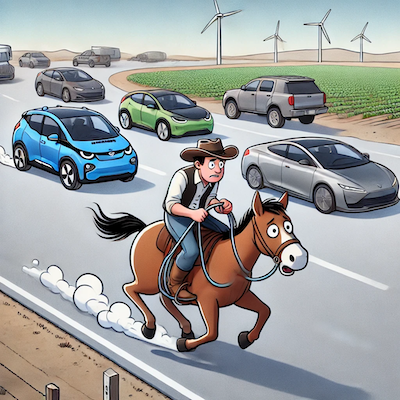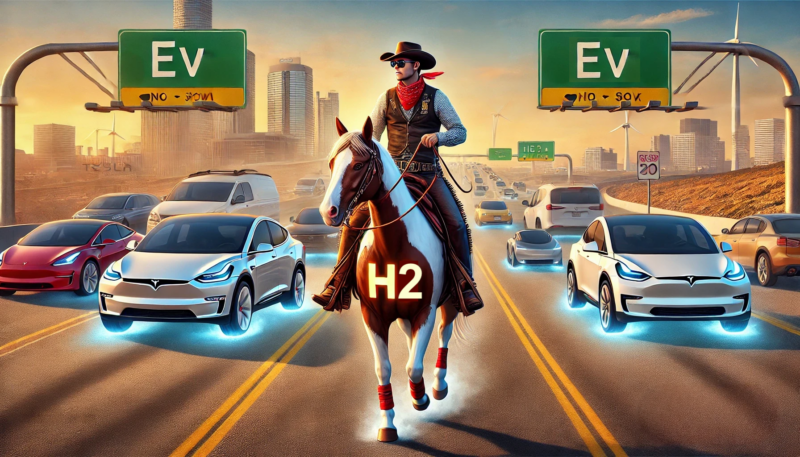 Sign up for daily news updates from CleanTechnica on email. Or follow us on Google News!
Sign up for daily news updates from CleanTechnica on email. Or follow us on Google News!
The belief that hydrogen will dominate the transportation sector is rooted in optimism rather than evidence. It appeals to the imagination but collapses under scrutiny. In practice, hydrogen is being decisively outpaced by two more efficient and cost-effective alternatives: battery electric vehicles and advanced biofuels. The appeal of hydrogen may lie in its futuristic sheen, but it is more akin to choosing a horse in the age of the automobile—needlessly complex, inefficient, and expensive.
This is a companion article to the Cranky Stepdad vs Hydrogen for Energy material. In a similar manner to John Cook’s Skeptical Science, the intent is a rapid and catchy debunk, a second level of detail in the Companion to Cranky Stepdad vs Hydrogen for Energy, and then a fuller article as the third level of detail.
 Hydrogen in transportation is like using a horse when cars are available—EVs and biofuels are just more efficient.
Hydrogen in transportation is like using a horse when cars are available—EVs and biofuels are just more efficient.
Hydrogen fuel cell vehicles (FCEVs) are fundamentally limited by energy inefficiency. From the moment electricity is generated to the point the vehicle moves, FCEVs squander much of that energy in hydrogen production, compression, distribution, and conversion back into electricity. In contrast, battery electric vehicles (BEVs) bypass most of that waste, delivering 70 to 90 percent well-to-wheel efficiency. In comparison, FCEVs achieve only 30 to 40 percent (Brenna, Foiadelli, & Zaninelli, 2021). These inefficiencies aren’t theoretical—they’re systemic and reflected in operating costs, infrastructure requirements, and energy use. A comprehensive study of European transport systems confirmed that BEVs are significantly more cost-effective and energy-efficient than hydrogen-powered vehicles and are thus more likely to dominate the road sector by 2035 (Rogstadius, 2023).
The discrepancy plays out clearly in vehicle deployment. Battery electric passenger vehicles, buses, and trucks vastly outnumber their hydrogen counterparts. In cities across Europe, Asia, and North America, fleets are transitioning to BEVs, driven by falling battery prices, robust charging networks, and superior operating economics. Hydrogen trucks and buses, once heavily promoted, remain stuck in pilot programs and niche demonstrations. The U.S. Department of Energy has consistently pointed out that hydrogen’s low efficiency and high fueling costs make it poorly suited to broad adoption in ground transport.
Hydrogen’s limitations extend beyond roads. In the maritime sector, the energy density of hydrogen—especially by volume—complicates ship design and fueling logistics. A peer-reviewed study of maritime decarbonization strategies found hydrogen-based fuels to be significantly more expensive and less efficient than alternatives like ammonia, battery-electric propulsion, and especially biofuels (Bouman et al., 2017). Hydrogen must be stored at high pressure or cryogenically cooled, consuming both space and energy—two precious resources on long-haul vessels. As a result, most credible shipping decarbonization scenarios do not prioritize hydrogen.
Aviation presents similar obstacles. While hydrogen is sometimes heralded as a long-term solution for flight, its volumetric energy density is far too low to be practical in large aircraft without radical airframe redesign. A 2018 Nature Energy study found that the technical and economic hurdles associated with hydrogen fuel—especially in storage and integration—make it a poor fit for aviation, at least in the near-to-mid term (Schafer et al., 2018). Instead, the leading pathway to decarbonize air travel involves sustainable aviation fuels (SAFs), which can be used in existing engines and infrastructure with minimal modification.
Further undermining the case for hydrogen dominance in air transport, the International Council on Clean Transportation (2023) concluded that hydrogen-powered planes would require not only major technological breakthroughs but also cryogenic fuel storage and oversized tanks that would dramatically reduce payload and range. SAFs, already being deployed in limited blends, are thus positioned as a more feasible and immediate alternative for long-haul decarbonization.
The recurring mistake in pro-hydrogen narratives is a classic logical fallacy: the appeal to possibility. Just because something is technically possible does not make it economically rational or systemically desirable. In this case, the possibility of hydrogen in transport is conflated with likelihood, in spite of mounting technical, financial, and infrastructural evidence to the contrary. The fallacy diverts attention and investment from the real decarbonization work already being done by batteries and biofuels—technologies that are available, scalable, and already winning in the marketplace.
Hydrogen may find niche applications—remote rail lines where direct electrification is not viable, or backup power for critical transport services—but it will not define the future of mobility. That future belongs to technologies that are efficient, adaptable, and supported by existing or easily developed infrastructure. Battery electric vehicles will lead in light-duty transport and urban logistics. Biofuels and SAFs will dominate longer-haul shipping and aviation. Hydrogen, once seen as a universal solution, is quickly being relegated to the margins.
The claim that hydrogen will dominate transportation is not supported by evidence. It is contradicted by technical realities, economic trends, and policy direction. Batteries and biofuels are the present—and future—of clean transport. Hydrogen is not the bridge; it’s the detour.
References
- Bouman, E. A., Lindstad, H. E., Rialland, A. I., & Strømman, A. H. (2017). State-of-the-art technologies for greenhouse gas emissions reduction in maritime transport. Transportation Research Part D: Transport and Environment, 52, 408–421.
- Brenna, M., Foiadelli, F., & Zaninelli, D. (2021). Comparative analysis of battery electric and hydrogen fuel cell vehicles: Efficiency, cost, and infrastructure. Energy Reports, 7, 5592–5604.
- International Council on Clean Transportation (ICCT). (2023). Hydrogen vs. Battery-Electric Aviation: Which is More Feasible?
- Rogstadius, J. (2023). Battery vs. hydrogen fuel cell road transport in Europe by 2035: A cost and efficiency analysis. International Journal of Hydrogen Energy, 48(5), 3021–3038.
- Schafer, A. W., Barrett, S. R. H., Doyme, K., Dray, L. M., Gnadt, A. R., Self, R., & O’Sullivan, A. (2018). Technological, economic, and environmental prospects of all-electric aircraft. Nature Energy, 3(3), 216–224.
Whether you have solar power or not, please complete our latest solar power survey.
Chip in a few dollars a month to help support independent cleantech coverage that helps to accelerate the cleantech revolution!
Have a tip for CleanTechnica? Want to advertise? Want to suggest a guest for our CleanTech Talk podcast? Contact us here.
Sign up for our daily newsletter for 15 new cleantech stories a day. Or sign up for our weekly one if daily is too frequent.
CleanTechnica uses affiliate links. See our policy here.
CleanTechnica’s Comment Policy

